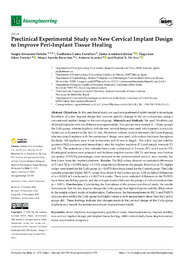Título :
Preclinical Experimental Study on New Cervical Implant Designto Improve Peri-Implant Tissue Healing |
Autor :
Gehrke, Sergio Alexandre
Castro Cortellari, Guillermo
Aramburú Junior, Jaime 
Eilers Treichel, Tiago Luis
Bianchini, Marco Aurelio
Scarano, Antonio
De Aza, Piedad  |
Editor :
MDPI |
Departamento:
Departamentos de la UMH::Ciencia de Materiales, Óptica y Tecnología Electrónica |
Fecha de publicación:
2024-11-16 |
URI :
https://hdl.handle.net/11000/34027 |
Resumen :
Objectives: In this preclinical study, we used an experimental rabbit model to investigate
the effects of a new implant design that involves specific changes to the cervical portion, using a
conventional implant design in the control group. Materials and Methods: We used 10 rabbits and
40 dental implants with two different macrogeometries. Two groups were formed (n = 20 per group):
the Collo group, wherein implants with the new cervical design were used, which present a concavity
(reduction in diameter) in the first 3.5 mm, the portion without surface treatment; the Control group,
wherein conical implants with the conventional design were used, with surface treatment throughout
the body. All implants were 4 mm in diameter and 10 mm in length. The initial implant stability
quotient (ISQ) was measured immediately after the implant insertion (T1) and sample removal (T2
and T3). The animals (n = five animals/time) were euthanized at 3 weeks (T1) and 4 weeks (T2).
Histological sections were prepared and the bone–implant contact (BIC%) and tissue area fraction
occupancy (TAFO%) percentages were analyzed in the predetermined cervical area; namely, the
first 4 mm from the implant platform. Results: The ISQ values showed no statistical differences
at T1 and T2 (p = 0.9458 and p = 0.1103, respectively) between the groups. However, at T3, higher
values were found for the Collo group (p = 0.0475) than those found for the Control group. The Collo
samples presented higher BIC% values than those of the Control group, with statistical differences
of p = 0.0009 at 3 weeks and p = 0.0007 at 4 weeks. There were statistical differences in the TAFO%
(new bone, medullary spaces, and the collagen matrix) between the groups at each evaluation time
(p < 0.001). Conclusions: Considering the limitations of the present preclinical study, the results
demonstrate that the new implant design (the Collo group) had higher implant stability (ISQ) values
in the samples after 4 weeks of implantation. Furthermore, the histomorphometric BIC% and TAFO%
analyses showed that the Collo group had higher values at both measurement times than the Control
group did. These findings indicate that changes made to the cervical design of the Collo group
implants may benefit the maintenance of peri-implant tissue health.
|
Palabras clave/Materias:
dental implants
macrogeometry
preclinical study
histomorphometry
implant stability |
Área de conocimiento :
CDU: Ciencias aplicadas |
Tipo de documento :
info:eu-repo/semantics/article |
Derechos de acceso:
info:eu-repo/semantics/openAccess |
DOI :
https://doi.org/10.3390/bioengineering11111155 |
Publicado en:
Bioengineering, 2024, 11, 1155 |
Aparece en las colecciones:
Artículos - Ciencia de los materiales, óptica y tecnología electrónica
|
 La licencia se describe como: Atribución-NonComercial-NoDerivada 4.0 Internacional.
La licencia se describe como: Atribución-NonComercial-NoDerivada 4.0 Internacional.
.png)
